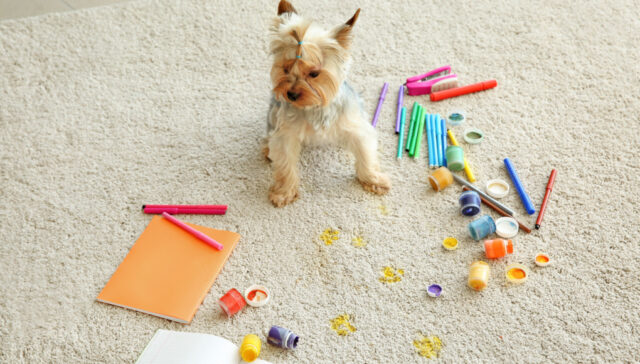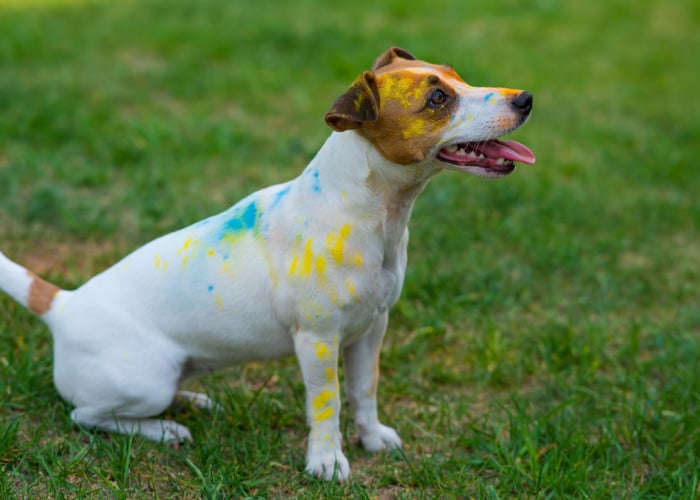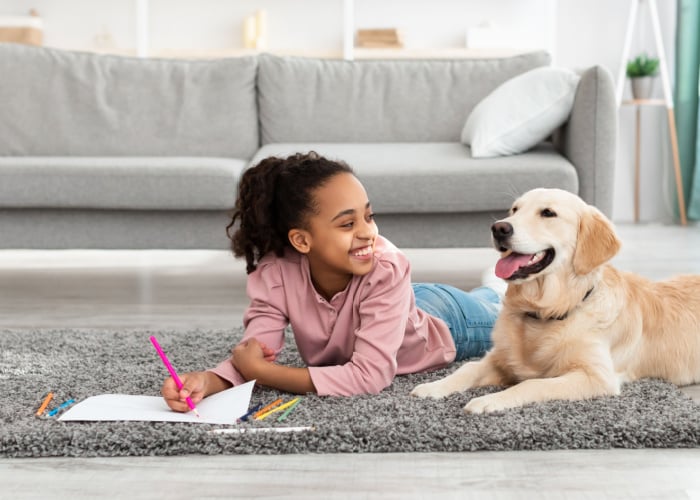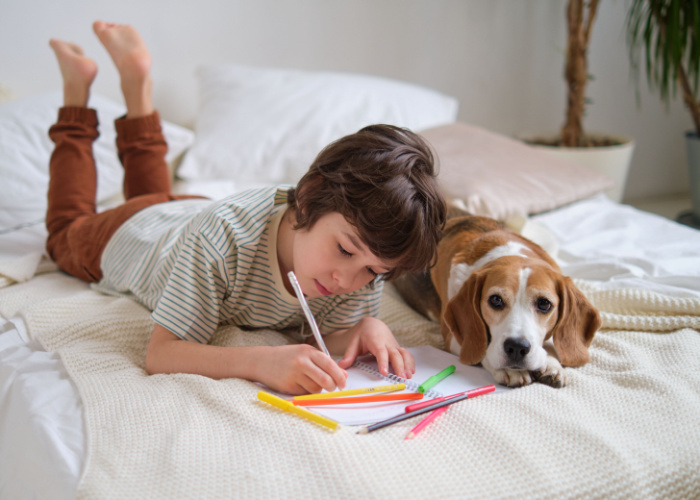
Table of Contents
- My Dog Ate Crayons: What To Do?
- Why Do Dogs Eat Crayons?
- Are Crayons Toxic to Dogs?
- What Happens When Your Dog Eats Crayons?
- 8 Practical Ways on How to Stop Your Dogs From Eating Crayons
- My Dog Ate Crayons: Before You Go…
Dogs eating crayons is not an uncommon occurrence at all.
Many pup owners have the same sentiments, too.
Myself included, I remembered the time when my dog ate crayons.
I panicked; I thought this weird behavior would send my 1-year-old pup to the vet.
Thankfully, my pup’s crayon-eating spree didn’t affect its health.
Only that I noticed streaks of color in its poop the day after.
But what I found out in my research today is quite alarming.
This is backed by a study from experts that claims that crayons may cause lead poisoning when ingested.
The “considerable amount (ranging from 0.03 to 24.27 ppm) of lead from crayons” is enough to pose a serious health threat to humans and animals.
This is because the toxicity of a heavy metal [lead] could become much higher when combined with other metals or agents with similar biochemical properties.
So, if your dogs have been feasting on crayons for quite some time now, then you must prevent it from happening again.
Don’t worry. I compiled all the vital juices you need to know as a pet owner.
Here’s a quick guide for you:
- What to do if your dogs ate crayons
- Why do dogs eat crayons
- Are crayons toxic to dogs
- What would happen if your dog ate crayons
- 8 Practical ways to stop your pup from eating crayons
Let’s get right into it!

My Dog Ate Crayons: What To Do?
If your dog ate crayons but seems fine, what you can do this time is still pay attention to your pup’s body reactions.
Whether your dog shows signs or not, here are some vital things you can do if your dog ate crayons:
Watch for Signs
Dogs eating crayons can happen at the most unexpected times.
While you can take preventive measures at home, you can’t always notice or catch your pups red-handed.
And the thing with some dogs is they don’t always show signs of trouble immediately after munching on an inedible snack.
So, you better be on the lookout for the following symptoms if your dog ate crayons:
If you notice your dog not acting its usual self, don’t hesitate to visit your vet immediately.
Or might as well follow the next option below.
Call the Pet Poison Helpline
For your dog’s general safety, call the Pet Poison Helpline at (855) 764 – 7661.
The Pet Poison Helpline is a 24/7 animal poison control center known as the only licensed veterinary contact center in the world.
In cases of emergency, the Pet Poison Helpline suggests the following instructions:
Step 1: Remove your dog from the area immediately.
Step 2: Check your dog for any breathing difficulty or abnormal reactions.
Step 3: Do not give any at-home medications or self-remedies.
Step 4: Avoid forcing your dog to vomit without consulting your vet or Pet Poison Helpline.
Step 5: Call the Pet Poison Helpline or contact your vet immediately.
You can also contact the following helplines below:
- America’s Poison Center (800) 222 -1222
- The Animal Poison Control Center of the ASPCA (888) 426 – 4435
Important: Be sure to have your vet’s active contact lines in case the above hotlines are not available.
Perform a Heimlich Maneuver on Your Choking Dog
If you notice your dog seemingly choking after eating crayons, this reminder from an expert might help save your pup’s life.
According to James Barr, clinical assistant professor at the Texas A&M College of Veterinary Medicine & Biomedical Sciences:
Pet owners should perform the Heimlich maneuver on their pet if they believe the pet is choking on something.
For your reference, take note of the following signs of choking in your dogs:
- Drooling
- Coughing
- Uneasiness
- Gagging or retching
- Pawing at the mouth
- Rubbing their face against the ground
- Blue to purple discoloration of the skin or gums due to low oxygen (cyanosis)
Note: Only perform the Heimlich maneuver if you do not have enough time to visit the vet. Ideally, have your vet on the phone to help walk you through the process.
For small and large canines, here’s a set of instructions for choking dogs:
Heimlich Maneuver for Small Dogs
Method 1
Step 1: Pick up your dog and hold it with its back to your front.
Step 2: Find the soft spot on their abdomen under their ribs.
Step 3: Using the thumb side of your fist, gently thrust inwards and upwards.
Method 2
Step 1: Lay your dog on its back.
Step 2: Find the soft spot on the abdomen under the ribs.
Step 3: Using the heel of your hand, gently press inwards and upwards.
Heimlich Maneuver for Large Dogs
Method 1
Step 1: Stand your dog on its hind legs and hold it like a person with its back to your front.
Step 2: Find the soft spot on the abdomen under the ribs.
Step 3: Using your fist, thrust inwards and upwards.
Method 2
Step 1: Lay your dog on its side.
Step 2: Find the soft spot on its abdomen under the ribs.
Step 3: Supporting your dog from the back, press a fist upwards and inwards toward its spine.
Why Do Dogs Eat Crayons?
For the record, dogs eat crayons out of curiosity.
And because crayons can easily look like an interesting toy, your dogs will chew them in no time.
Another reason why dogs tend to feast on crayons is because they’re teething.
Especially when they’re still puppies, your dog's gums can become painful while their teeth are growing.
So, chewing and nibbling too much is a common thing for puppies.
However, be on the safe side as much as possible.
Keep potential choking hazards away from your pup’s reach.
Or give your young Fidos something safe like chew toys.
Are Crayons Toxic to Dogs?
While crayons appear to be harmless, a study actually found out that this colorful product “could have varying levels of lead.”
Although in general they are not toxic and are less messy than some of other art materials, they can have varying levels of lead contamination.
So, it’s best to keep crayons away from your dogs whenever you can.

What Happens When Your Dog Eats Crayons?
Like what we've mentioned above, too much ingestion of crayons can cause lead poisoning.
Lead poisoning in dogs is a serious health threat.
If lead is consumed, your dogs can suffer from alarming health problems such as:
- Infertility
- Renal disease
- Immunosuppression
- Gastrointestinal upset
- Neurologic disturbances
- Hematologic abnormalities
“The nature of the clinical manifestations is influenced by the dose and duration of lead exposure.”
— Barry R. Blakley , DVM, Ph.D., Department of Veterinary Biomedical Sciences, Western College of Veterinary Medicine, University of Saskatchewan
Symptoms of Lead Poisoning in Dogs
Lead poisoning in dogs is commonly characterized by gastrointestinal issues, such as the following:
- Vomiting
- Diarrhea
- Anorexia
- Constipation
- Stomach discomfort
How is lead absorbed in your dog’s body?
When lead enters the bloodstream and is absorbed in the tissues, it eventually redistributes to the bone.
The level of absorption and the amount of time lead stays in your dog’s body is influenced by dietary factors present such as calcium or iron.
How do vets treat lead poisoning in dogs?
Since lead and other heavy metals displace calcium in the body, many veterinarians will use EDTA (Calcium Disodium) as a chelation agent…
Dr. Evan Ware, owner of Laveen Veterinary Center and Phoenix Veterinary Center, suggests that EDTA (Edetate Calcium Disodium) helps eliminate lead levels in your pup’s blood.
This treatment also increases calcium levels throughout your dog’s body.
“Blood lead concentration levels must be tested and then monitored throughout EDTA therapy until lead levels drop to normal.”
8 Practical Ways on How to Stop Your Dogs From Eating Crayons
While you can’t literally stop your dogs from chewing, you can definitely prevent them from feasting on crayons, right?
So, follow these easy and practical suggestions below:
1. Keep Crayons Away
To prevent compromising your pup’s health, the best thing to do is to keep crayons out of their reach.
The goal is to keep your dogs safe from feasting on the wrong snack or chewing inappropriate stuff at home.
2. Keep Your Pups Away From Your Kid’s Room
Kids love artsy stuff.
And while they’re doing fun coloring activities, your dogs might want to harness their inner creativity, too.
This doesn’t necessarily mean banning your pups from spending time with your kids.
But if they’re playing with potentially hazardous products like crayons, it’s best to supervise and keep an eye on them at all times.
3. Have Chew Toys Ready
Yup, chew toys are essential for your dogs.
Especially if you have teething puppies, you’ll likely bump into broken furniture or torn socks at home.
While this comes naturally in younger dogs, you should properly disassociate them from such behavior.
Luckily, chew toys can help you achieve that.
4. Dog-proof Your Home
You don’t want your dogs to nibble on things they shouldn’t, right?
So, might as well dog-proof your home for your Fido’s safety.
On top of the tips I listed above, putting pet gates at home adds that extra level of security.
Not only will it limit your pup’s exposure to crayons and other inedible stuff, but pet gates also prevent them from scouring your trash cans.
Or eat poisonous plants in your backyard.
5. Engage Your Dogs in Walks and Fun Activities
Nothing beats a good morning or afternoon walk in the park with your furballs.
To prevent your heavy chewers from feasting on crayons, let them burn their energy in fun outdoor activities.
The goal is to mentally stimulate your pups so that their daily activities don’t only revolve around chewing stuff.
Your dogs can also have a variety of activities to do apart from ripping off your furniture or munching on crayons.
Tip: Offer a variety of interactive dog toys, too.
6. Have Somebody Pet-sit Your Pups When You’re Not Around
Another underlying reason why your dogs love to chew so much is because they’re anxious.
Especially dogs left for longer periods, they’re prone to anxiety and aggressive chewing.
So, have somebody pet-sit your pups at home whenever you’re outdoors for a long time.
You can have somebody walk your dogs, too.
RELATED: Best Dog Sitter Websites
7. Essential Oils Can Help, Too
A study found that olfactory stimulation or your dog’s sense of smell directly affects a dog’s behavior.
Interestingly, dogs spend more time resting and less time moving when they are exposed to lavender and chamomile.
The same study also claims that dogs that are exposed to lavender and chamomile showed “less vocalization.”
A rosemary and peppermint-diffused environment, on the other hand, impacts dog behavior, too.
The study found dogs to be “significantly more standing, moving and vocalizing” than other aromas.
With this interesting information in mind, you can try to put an oil diffuser at home as a natural way to calm your dog’s senses.
This helps stimulate your heavy-chewing pup’s behavior and mood.
RELATED: 9 Reasons to Use Essential Oils for Dogs
8. Use Effective Training Techniques
The treatment and training you impose on your pups must be rewarding and healthy at all times.
And especially shelter dogs, they could be victims of harsh treatment by their previous owners commonly known as punishment syndrome.
This syndrome can come in forms such as:
- Screaming
- Raising voice
- Physical abuse
The same is true for imposing aversive training on dogs.
What is Aversive Training in Dogs?
Aversive training refers to behavior therapy that involves the following:
- Positive Punishment: Adding something to decrease a certain behavior
- Negative Reinforcement: Removing something to increase a certain behavior
This is done to eliminate a dog's bad behavior that is often associated with the use of aversive tools like:
- Shaker cans
- Invisible fence collars
- Shock (Electric) collars
- Citronella spray collars
- Prong and choke collars
However, the results show more harm than good in the long run.
And as a result, your dogs don't actually get rid of the negative behavior but are only suppressing it.
In the same context, your dogs will stop doing something bad because of the discomfort and pain they feel from electric collars, for example.
According to a study, using these 2 methods at the same time can trigger aggression, fear, and anxiety in dogs in the long run.
What Should You Do Then?
You can focus on positive reinforcement methods, which are broken into the following:
- Positive: Something is added
- Reinforcement: Frequency
For example:
Giving yummy treats to your dogs when they follow a command.
So, your pup will likely repeat the same cue (frequency) because you're rewarding them with their favorite food (something is added).
Another thing you can do is to try clicker training for your pups at home.
Also known as marker training, using a clicker tool helps your dog remember it did something favorable.
Normally, a reward must follow immediately after each click.

My Dog Ate Crayons: Before You Go…
Hearing “my dog ate crayons” type of sentiments from pup owners isn’t a new thing.
Besides normal puppy behavior, crayon eating is your pup’s way of aiding gum pain during their teething stage.
Dogs eating crayons can be a sign of anxiety and lack of exercise, too.
So, focus on offering a variety of activities for your dogs so that they will not regard chewing as the only entertaining part of the day.
Found this blog helpful?
Check out some of our top recommendations below!












